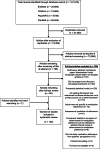An Adaptable Framework for Factors Contributing to Medication Adherence: Results from a Systematic Review of 102 Conceptual Frameworks
- PMID: 33660211
- PMCID: PMC8390603
- DOI: 10.1007/s11606-021-06648-1
An Adaptable Framework for Factors Contributing to Medication Adherence: Results from a Systematic Review of 102 Conceptual Frameworks
Abstract
Objective: To summarize the available conceptual models for factors contributing to medication adherence based on the World Health Organization (WHO)'s five dimensions of medication adherence via a systematic review, identify the patient groups described in available conceptual models, and present an adaptable conceptual model that describes the factors contributing to medication adherence in the identified patient groups.
Methods: We searched PubMed®, Embase®, CINAHL®, and PsycINFO® for English language articles published from inception until 31 March 2020. Full-text original publications in English that presented theoretical or conceptual models for factors contributing to medication adherence were included. Studies that presented statistical models were excluded. Two authors independently extracted the data.
Results: We identified 102 conceptual models, and classified the factors contributing to medication adherence using the WHO's five dimensions of medication adherence, namely patient-related, medication-related, condition-related, healthcare system/healthcare provider-related, and socioeconomic factors. Eight patient groups were identified based on age and disease condition. The most universally addressed factors were patient-related factors. Medication-related, condition-related, healthcare system-related, and socioeconomic factors were represented to various extents depending on the patient group. By systematically examining how the WHO's five dimensions of medication adherence were applied differently across the eight different patient groups, we present a conceptual model that can be adapted to summarize the common factors contributing to medication adherence in different patient groups.
Conclusion: Our conceptual models can be utilized as a guide for clinicians and researchers in identifying the facilitators and barriers to medication adherence and developing future interventions to improve medication adherence.
Protocol registration: PROSPERO Identifier: CRD42020181316.
© 2021. The Author(s).
Conflict of interest statement
The authors declare that they do not have a conflict of interest.
Figures
Similar articles
-
Survivor, family and professional experiences of psychosocial interventions for sexual abuse and violence: a qualitative evidence synthesis.Cochrane Database Syst Rev. 2022 Oct 4;10(10):CD013648. doi: 10.1002/14651858.CD013648.pub2. Cochrane Database Syst Rev. 2022. PMID: 36194890 Free PMC article.
-
Interventions for promoting habitual exercise in people living with and beyond cancer.Cochrane Database Syst Rev. 2018 Sep 19;9(9):CD010192. doi: 10.1002/14651858.CD010192.pub3. Cochrane Database Syst Rev. 2018. PMID: 30229557 Free PMC article.
-
Barriers and facilitators to implementation of evidence-based task-sharing mental health interventions in low- and middle-income countries: a systematic review using implementation science frameworks.Implement Sci. 2022 Jan 12;17(1):4. doi: 10.1186/s13012-021-01179-z. Implement Sci. 2022. PMID: 35022081 Free PMC article.
-
A systematic review of the barriers affecting medication adherence in patients with rheumatic diseases.Rheumatol Int. 2017 Oct;37(10):1619-1628. doi: 10.1007/s00296-017-3763-9. Epub 2017 Jul 5. Rheumatol Int. 2017. PMID: 28681249
-
Factors that influence parents' and informal caregivers' views and practices regarding routine childhood vaccination: a qualitative evidence synthesis.Cochrane Database Syst Rev. 2021 Oct 27;10(10):CD013265. doi: 10.1002/14651858.CD013265.pub2. Cochrane Database Syst Rev. 2021. PMID: 34706066 Free PMC article.
Cited by
-
Interventions to promote medication adherence for chronic diseases in India: a systematic review.Clin Med (Lond). 2023 Nov;23(Suppl 6):72-73. doi: 10.7861/clinmed.23-6-s72. Clin Med (Lond). 2023. PMID: 38182230 Free PMC article. No abstract available.
-
Improving Type 2 Diabetes Care with Extended-Release Metformin: Real-Life Insights from a Physician Educational Program.Endocr Metab Immune Disord Drug Targets. 2024;24(12):1422-1430. doi: 10.2174/0118715303294909240221102552. Endocr Metab Immune Disord Drug Targets. 2024. PMID: 38425116 Free PMC article.
-
Exploring the emotional impact of axial Spondyloarthritis: a systematic review and thematic synthesis of qualitative studies and a review of social media.BMC Rheumatol. 2023 Aug 23;7(1):26. doi: 10.1186/s41927-023-00351-w. BMC Rheumatol. 2023. PMID: 37608395 Free PMC article.
-
Factors influencing adult and adolescent completion of treatment for late syphilis: a mixed methods systematic review.Bull World Health Organ. 2025 May 1;103(5):316-327E. doi: 10.2471/BLT.24.291684. Epub 2025 Apr 1. Bull World Health Organ. 2025. PMID: 40342852 Free PMC article.
-
Development and Validation of a Tool to Explore Attitudes Towards meDication adHErence Using a Novel Self-Reported QuestionnairE (ADHERE-7).Pharmacy (Basel). 2024 Jul 18;12(4):113. doi: 10.3390/pharmacy12040113. Pharmacy (Basel). 2024. PMID: 39051397 Free PMC article.
References
-
- World Health Organization . Adherence to Long-Term Therapies: Evidence For Action. Geneva: World Health Organization; 2003.
-
- Gellad WF, et al. The myths of medication adherence. Pharmacoepidemiol Drug Saf. 2017;26(12):1437–1441. - PubMed
-
- DiMatteo MR. Variations in Patients' Adherence to Medical Recommendations: A Quantitative Review of 50 Years of Research. Med Care. 2004;42(3):200–209. - PubMed
-
- Jackevicius CA, Mamdani M, Tu JV. Adherence With Statin Therapy in Elderly Patients With and Without Acute Coronary Syndromes. JAMA. 2002;288(4):462–467. - PubMed
Publication types
MeSH terms
Grants and funding
LinkOut - more resources
Full Text Sources
Other Literature Sources



